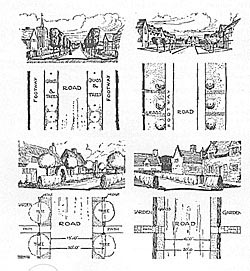One of the early difficulties to be overcome was that the new ideas of development in the minds of Henrietta Barnett and Raymond Unwin ran counter to established practice. The first Town Planning Act (1909) was not yet on the Statute Book and urban development was controlled by local bye-laws and regulations and was rigid rather than creative and flexible. George Cadbury, anxious to put his garden city ideas into practice at Bournville, had already found himself hampered by the bye-laws. At this time enlightened developers could only secure flexibility in rural districts. For this reason Joseph Rowntree was developing New Earswick in a rural district near York, and the First Garden City Company was starting to develop at Letchworth, in a rural part of Hertfordshire. Raymond Unwin was the architect for both.

Fig 3
Examples of roads and drives used at Earswick, Letchworth and Hampstead
In order to overcome the restrictions imposed by the bye-laws, the Hampstead Garden Suburb Trust promoted a Private Bill designed to give them the necessary powers. It passed into law as the Hampstead Garden Suburb Act, 1906. The important provisions of the Act, which only applied to approximately the original Suburb were -
Section 2
- "There shall not be built in the Garden Suburb on the average throughout a greater proportion of houses to the acre than eight".
- "On every road in the Garden Suburb (whatever the width of the said road) there shall be between any two houses standing on opposite sides of the road a space not less than fifty feet free of any buildings except walls, fences or gates."
Section 3
"With respect to any gardens, recreation grounds or open spaces provided by the Company for the common use of the inhabitants of any dwellings in the Garden Suburb the Company may make bye-laws for the regulation thereof...." Bye-laws were so made.
Section 5
Dealt with the laying out and making of roads and suspended the operation of local bye-laws under certain conditions. It recognised the difference between cul-de-sac roads of limited length and other roads:
"Any road not exceeding 500 feet in length constructed primarily for the purpose of giving access to a group of houses in the Garden Suburb and not designed for the purposes of through traffic (known as an accommodation road), may with the consent of the local authority be exempted from any operation of any bye-laws of the local authority relating to the width of new streets and footways."
In addition to allowing Unwin's ideas for the development of the Garden Suburb to go ahead and to act as an example for future residential development, the 1906 Act was the foundation stone upon which the first Town Planning Act was built.
|





